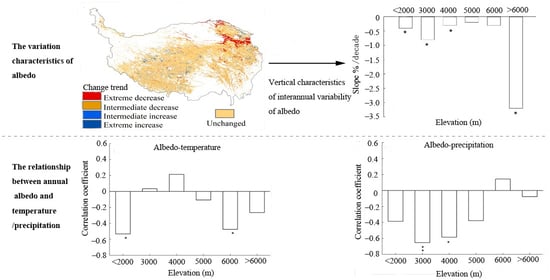The Impact of Climate Change on the Surface Albedo over the Qinghai-Tibet Plateau
Abstract
1. Introduction
2. Materials and Methods
2.1. Study Area and Data Source
2.2. Methods
3. Results
3.1. The Spatial Pattern of Albedo
3.2. The Spatiotemporal Variation of Albedo
3.3. The Response of Albedo to Climate Change
3.3.1. Spatial Correlation Analysis
3.3.2. Temporal Correlation Analysis
4. Discussion
5. Conclusions
Author Contributions
Funding
Acknowledgments
Conflicts of Interest
References
- Tian, L.; Chen, J.Q.; Zhang, Y.J. Growing season carries stronger contributions to albedo dynamics on the Tibetan Plateau. PLoS ONE 2017, 12, e0180559. [Google Scholar] [CrossRef]
- Zheng, L.; Zhao, G.S.; Dong, J.W.; Ge, Q.S.; Tao, J.; Zhang, X.Z.; Qi, Y.C.; Doughty, R.B.; Xiao, X.M. Spatial, temporal, and spectral variations in albedo due to vegetation changes in China’s grasslands. ISPRS J. Photogramm. Remote Sens. 2019, 152, 1–12. [Google Scholar] [CrossRef]
- Kuhle, M. A relief-specific model of the ice age on the basis of uplift-controlled glacier areas in Tibet and the corresponding albedo increase as well as their positive climatological feedback by means of the global radiation geometry. Clim. Res. 2002, 20, 1–7. [Google Scholar] [CrossRef]
- Li, Y.; Hu, Z. A study on parameterization of surface albedo over grassland surface in the northern Tibetan Plateau. Adv. Atmos. Sci. 2009, 26, 161–168. [Google Scholar] [CrossRef]
- Perkins, S. Albedo is a simple concept that plays complicated roles in climate and astronomy. Proc. Natl. Acad. Sci. USA 2019, 116, 25369–25371. [Google Scholar] [CrossRef]
- Guan, Y.L.; Lu, H.W.; Yin, C.; Xue, Y.X.; Jiang, Y.L.; Kang, Y.; He, L.; Heiskanen, J. Vegetation response to climate zone dynamics and its impacts on surface soil water content and albedo in China. Sci. Total Environ. 2020, 747, 141537. [Google Scholar] [CrossRef]
- Kala, J.; Hirsch, A.L. Could crop albedo modification reduce regional warming over Australia? Weather Clim. Extrem. 2020, 30, 100282. [Google Scholar] [CrossRef]
- Charney, J.; Quirk, W.J.; Chow, S.H.; Kornfield, J. Comparative-study of effects of albedo change on drought in semi-arid regions. J. Atmos. Sci. 1977, 34, 1366–1385. [Google Scholar] [CrossRef]
- Knorr, W.; Schnitzler, K.G.; Govaerts, Y. The role of bright desert regions in shaping North African climate. Geophys. Res. Lett. 2001, 28, 3489–3492. [Google Scholar] [CrossRef]
- Tian, L.; Chen, J.Q.; Shao, C.L. Interdependent dynamics of lai-albedo across the roofing landscapes: Mongolian and Tibetan Plateaus. Remote Sens. 2018, 10, 1159. [Google Scholar] [CrossRef]
- Tian, L.; Zhang, Y.J.; Zhu, J.T. Decreased surface albedo driven by denser vegetation on the Tibetan Plateau. Environ. Res. Lett. 2014, 9, 104001. [Google Scholar] [CrossRef]
- Li, J.C.; Yao, Q.; Zhou, N.; Li, F.H. Modern aeolian desertification on the Tibetan Plateau under climate change. Land Degrad. Dev. 2021, 32, 1908–1916. [Google Scholar] [CrossRef]
- Zhao, J.X.; Luo, T.X.; Wei, H.X.; Deng, Z.H.; Li, X.; Li, R.C.; Tang, Y.H. Increased precipitation offsets the negative effect of warming on plant biomass and ecosystem respiration in a Tibetan alpine steppe. Agric. For. Meteorol. 2019, 279, 107761. [Google Scholar] [CrossRef]
- Lang, J.; Lyu, S.; Li, Z.; Ma, Y.; Su, D. An investigation of ice surface albedo and its influence on the high-altitude lakes of the Tibetan Plateau. Remote Sens. 2018, 10, 218. [Google Scholar] [CrossRef]
- Yue, X.Y.; Zhao, J.; Li, Z.Q.; Zhang, M.J.; Fan, J.; Wang, L.; Wang, P.Y. Spatial and temporal variations of the surface albedo and other factors influencing Urumqi Glacier No. 1 in Ttien Shan, China. J. Glaciol. 2017, 63, 899–911. [Google Scholar] [CrossRef]
- Li, X.J.; Zhang, H.Y.; Qu, Y. Land surface albedo variations in SanJiang plain from 1982 to 2015: Assessing with glass data. Chin. Geogr. Sci. 2020, 30, 876–888. [Google Scholar] [CrossRef]
- Culf, A.D.; Fisch, G.; Hodnett, M.G. The albedo of Amazonian forest and ranch land. J.Clim. 1995, 8, 1544–1554. [Google Scholar] [CrossRef]
- Berbert, M.L.C.; Costa, M.H. Climate change after tropical deforestation: Seasonal variability of surface albedo and its effects on precipitation change. J. Clim. 2003, 16, 2099–2104. [Google Scholar] [CrossRef]
- Huang, K.; Zhang, Y.J.; Tagesson, T.; Brandt, M.; Wang, L.H.; Chen, N.; Zu, J.X.; Jin, H.X.; Cai, Z.Z.; Tong, X.W.; et al. The confounding effect of snow cover on assessing spring phenology from space: A new look at trends on the Tibetan Plateau. Sci. Total Environ. 2021, 756, 144011. [Google Scholar] [CrossRef]
- Schaaf, C.B.; Gao, F.; Strahler, A.H.; Lucht, W.; Li, X.W.; Tsang, T.; Strugnell, N.C.; Zhang, X.Y.; Jin, Y.F.; Muller, J.P.; et al. First operational BRDF, albedo nadir reflectance products from MODIS. Remote Sens. Environ. 2002, 83, 135–148. [Google Scholar] [CrossRef]
- Zhu, W.B.; Zhang, X.D.; Zhang, J.J.; Zhu, L.Q. A comprehensive analysis of phenological changes in forest vegetation of the Funiu Mountains, China. J. Geogr. Sci. 2019, 29, 131–145. [Google Scholar] [CrossRef]
- Yao, T.; Wu, F.; Ding, L.; Sun, J.; Zhu, L.; Piao, S.L.; Deng, T.; Ni, X.; Zheng, H.; Ouyang, H. Multispherical interactions and their effects on the Tibetan Plateau’s earth system: A review of the recent researches. Natl. Sci. Rev. 2015, 2, 468–488. [Google Scholar] [CrossRef]
- Kiehl, J.T.; Hack, J.J.; Hurrell, J.W. The energy budget of the NCAR Community Climate Model: CCM3. J. Clim. 1998, 11, 1151–1178. [Google Scholar] [CrossRef]
- Shao, C.L.; Li, L.h.; Dong, G.; Chen, J.Q. Spatial variation of net radiation and its contribution to energy balance closures in grassland ecosystems. Ecol. Proces. 2014, 3, D05107. [Google Scholar] [CrossRef]
- Loranty, M.M.; Berner, L.T.; Goetz, S.J.; Jin, Y.F.; Randerson, J.T. Vegetation controls on northern high latitude snow-albedo feedback: Observations and CMIP5 model simulations. Glob. Chang. Biol. 2014, 20, 594–606. [Google Scholar] [CrossRef] [PubMed]
- Planque, C.; Carrer, D.; Roujean, J.L. Analysis of MODIS albedo changes over steady woody covers in France during the period of 2001-2013. Remote Sens. Environ. 2017, 191, 13–29. [Google Scholar] [CrossRef]
- Pistone, K.; Eisenman, I.; Ramanathan, V. Observational determination of albedo decrease caused by vanishing Arctic sea ice. Proc. Natl. Acad. Sci. USA 2014, 111, 3322–3326. [Google Scholar] [CrossRef] [PubMed]
- Rangwala, I.; Miller, J.R. Climate change in mountains: A review of elevation-dependent warming and its possible causes. Clim. Chang. 2012, 114, 527–547. [Google Scholar] [CrossRef]
- He, T.; Liang, S.; Yu, Y.; Wang, D.; Gao, F.; Liu, Q. Greenland surface albedo changes in July 1981-2012 from satellite observations. Environ. Res. Lett. 2013, 8, 044043. [Google Scholar] [CrossRef]
- Sciusco, P.; Chen, J.Q.; Abraha, M.; Lei, C.; Robertson, G.P.; Lafortezza, R.; Shirkey, G.; Ouyang, Z.T.; Zhang, R.; John, R. Spatiotemporal variations of albedo in managed agricultural landscapes: Inferences to global warming impacts (GWI). Landsc. Ecol. 2020, 35, 1385–1402. [Google Scholar] [CrossRef]
- Zhang, Q.; Kong, D.D.; Shi, P.J.; Singh, V.P.; Sun, P. Vegetation phenology on the Qinghai-Tibetan Plateau and its response to climate change (1982–2013). Agric. For. Meteorol. 2018, 248, 408–417. [Google Scholar] [CrossRef]
- Ghatak, D.; Sinsky, E.; Miller, J. Role of snow-albedo feedback in higher elevation warming over the Himalayas, Tibetan Plateau and Central Asia. Environ. Res. Lett. 2014, 9, 114008. [Google Scholar] [CrossRef]
- Lin, X.W.; Wen, J.G.; Liu, Q.H.; You, D.Q.; Wu, S.B.; Hao, D.L.; Xiao, Q.; Zhang, Z.Y.; Zhang, Z.Z. Spatiotemporal variability of land surface albedo over the Tibet Plateau from 2001 to 2019. Remote Sens. 2020, 12, 1188. [Google Scholar] [CrossRef]
- Chuine, I.; Morin, X.; Bugmann, H. Warming, photoperiods, and tree phenology. Science 2010, 329, 277–278. [Google Scholar] [CrossRef]
- Lian, X.; Piao, S.L.; Li, L.Z.X.; Li, Y.; Huntingford, C.; Ciais, P.; Cescatti, A.; Janssens, I.A.; Penuelas, J.; Buermann, W.; et al. Summer soil drying exacerbated by earlier spring greening of northern vegetation. Sci. Adv. 2020, 6, eaax0255. [Google Scholar] [CrossRef]
- Fu, Y.S.; Li, X.X.; Zhou, X.C.; Geng, X.J.; Guo, Y.H.; Zhang, Y.R. Progress in plant phenology modeling under global climate change. Sci. China Earth Sci. 2020, 63, 1237–1247. [Google Scholar] [CrossRef]
- Xue, X.; Guo, J.; Han, B.; Sun, Q.; Liu, L. The effect of climate warming and permafrost thaw on desertification in the Qinghai-Tibetan Plateau. Geomorphology 2009, 108, 182–190. [Google Scholar] [CrossRef]
- You, Q.; Xue, X.; Peng, F.; Dong, S.; Gao, Y. Surface water and heat exchange comparison between alpine meadow and bare land in a permafrost region of the Tibetan Plateau. Agric. For. Meteorol. 2017, 232, 48–65. [Google Scholar] [CrossRef]
- Wang, S.Y.; Yang, B.J.; Yang, Q.C.; Lu, L.L.; Wang, X.Y.; Peng, Y.Y. Temporal trends and spatial variability of vegetation phenology over the northern hemisphere during 1982-2012. PLoS ONE 2016, 11, e0157134. [Google Scholar] [CrossRef]
- Yi, S.H.; Zhou, Z.Y.; Ren, S.L.; Xu, M.; Qin, Y.; Chen, S.Y.; Ye, B.S. Effects of permafrost degradation on alpine grassland in a semi-arid basin on the Qinghai-Tibetan Plateau. Environ. Res. Lett. 2011, 6, 045403. [Google Scholar] [CrossRef]
- Taylor, P.C.; Kato, S.; Xu, K.M.; Cai, M. Covariance between arctic sea ice and clouds within atmospheric state regimes at the satellite footprint level. J. Geophys. Res. Atmos. 2015, 120, 12656–12678. [Google Scholar] [CrossRef]
- Wild, M.; Hakuba, M.Z.; Folini, D.; Schar, C.; Long, C. New estimates of the earth radiation budget under cloud-free conditions and cloud radiative effects. In Radiation Processes in the Atmosphere and Ocean; Davies, R., Egli, L., Schmutz, W., Eds.; Amer Inst Physics: Melville, NY, USA, 2017; p. 1810. [Google Scholar]
- Chen, J.; Wan, S.; Henebry, G.; Gutman, G.; Sun, G.; Kappas, M. Dryland East Asia: Land Dynamics Amid Social and Climate Change; Higher Education Press: Beijing, China, 2013. [Google Scholar]
- Li, B.Q.; Zhou, W.; Zhao, Y.Y.; Ju, Q.; Yu, Z.B.; Liang, Z.M.; Acharya, K. Using the SPEI to assess recent climate change in the Yarlung Zangbo River Basin, South Tibet. Water 2015, 7, 5474–5486. [Google Scholar] [CrossRef]
- Huai, B.J.; Wang, J.Y.; Sun, W.J.; Wang, Y.T.; Zhang, W.Y. Evaluation of the near-surface climate of the recent global atmospheric reanalysis for Qilian Mountains, Qinghai-Tibet Plateau. Atmos. Res. 2021, 250, 105401. [Google Scholar] [CrossRef]
- Jin, Z.; You, Q.L.; Wu, F.Y.; Sun, B.; Cai, Z.Y. Changes of climate and climate extremes in the Three-Rivers Headwaters’ Region over the Tibetan Plateau during the past 60 years. Trans. Atmos. Sci. 2020, 43, 1042–1055. [Google Scholar]
- Hu, C.; Jiang, D.P.; Fan, G.Z. Climate change projection on the Tibetan Plateau: Results of CMIP5 models. Chin. J. Atmo. Sci. 2015, 39, 260–270. [Google Scholar]
- Tian, F.; Wigneron, J.P.; Ciais, P.; Chave, J.; Ogee, J.; Penuelas, J.; Raebild, A.; Domec, J.C.; Tong, X.Y.; Brandt, M.; et al. Coupling of ecosystem-scale plant water storage and leaf phenology observed by satellite. Nat. Ecol. Evol. 2018, 2, 1428–1435. [Google Scholar] [CrossRef] [PubMed]
- Zhang, X.Z. The responses of surface albedo to climatic changes in Xilin Gol grassland. Geogr. Res. Aust. 2012, 31, 299–310. [Google Scholar]
- Guan, Y.L.; Wang, R.H.; Yao, J.; Qin, J.K.; Zhu, M. Features of surface albedo of Tianshan Mountains area under the background of climate change. Arid Land Geogr. 2015, 38, 351–358. [Google Scholar]
- Wang, Z.S.; Schaaf, C.B.; Strahler, A.H.; Chopping, M.J.; Roman, M.O.; Shuai, Y.M.; Woodcock, C.E.; Hollinger, D.Y.; Fitzjarrald, D.R. Evaluation of MODIS albedo product (MCD43A) over grassland, agriculture and forest surface types during dormant and snow-covered periods. Remote Sens. Environ. 2014, 140, 60–77. [Google Scholar] [CrossRef]
- Roesch, A.; Schaaf, C.; Gao, F. Use of Moderate-Resolution Imaging Spectroradiometer bidirectional reflectance distribution function products to enhance simulated surface albedos. J. Geophys. Res. Atmos. 2004, 109, D12105. [Google Scholar] [CrossRef]
- Liu, J.C.; Schaaf, C.; Strahler, A.; Jiao, Z.T.; Shuai, Y.M.; Zhang, Q.L.; Roman, M.; Augustine, J.A.; Dutton, E.G. Validation of Moderate Resolution Imaging Spectroradiometer (MODIS) albedo retrieval algorithm: Dependence of albedo on solar zenith angle. J. Geophys. Res. Atmos. 2009, 114, D01106. [Google Scholar] [CrossRef]
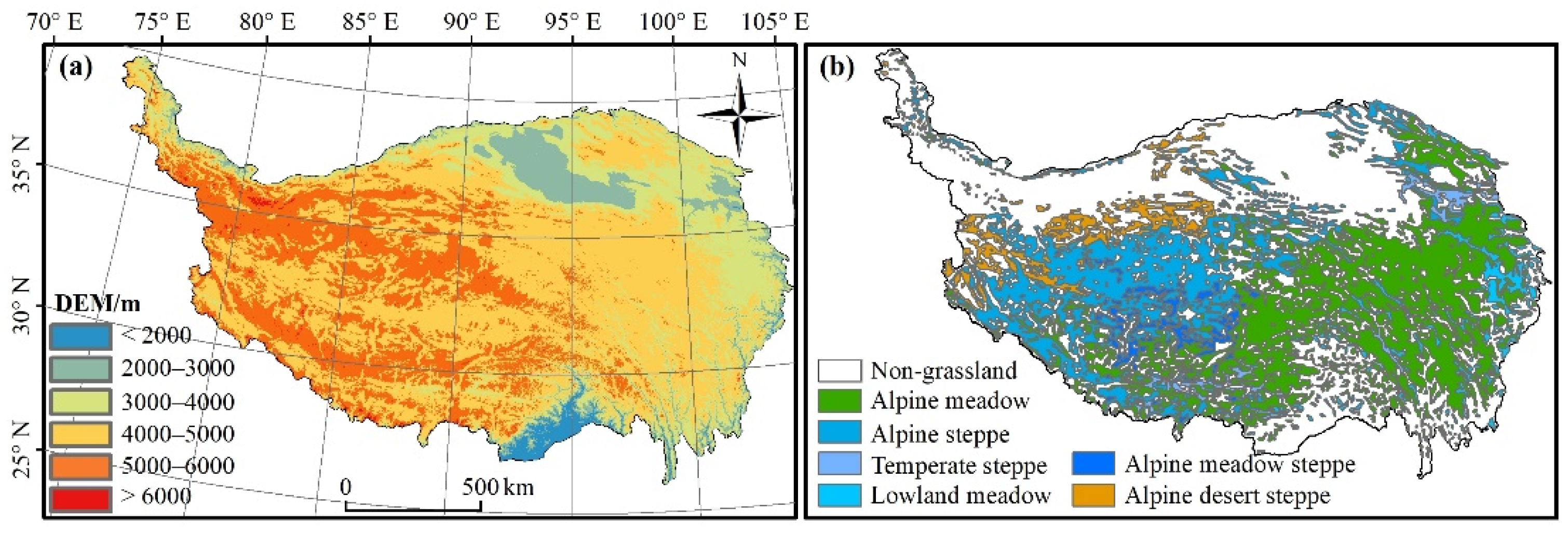
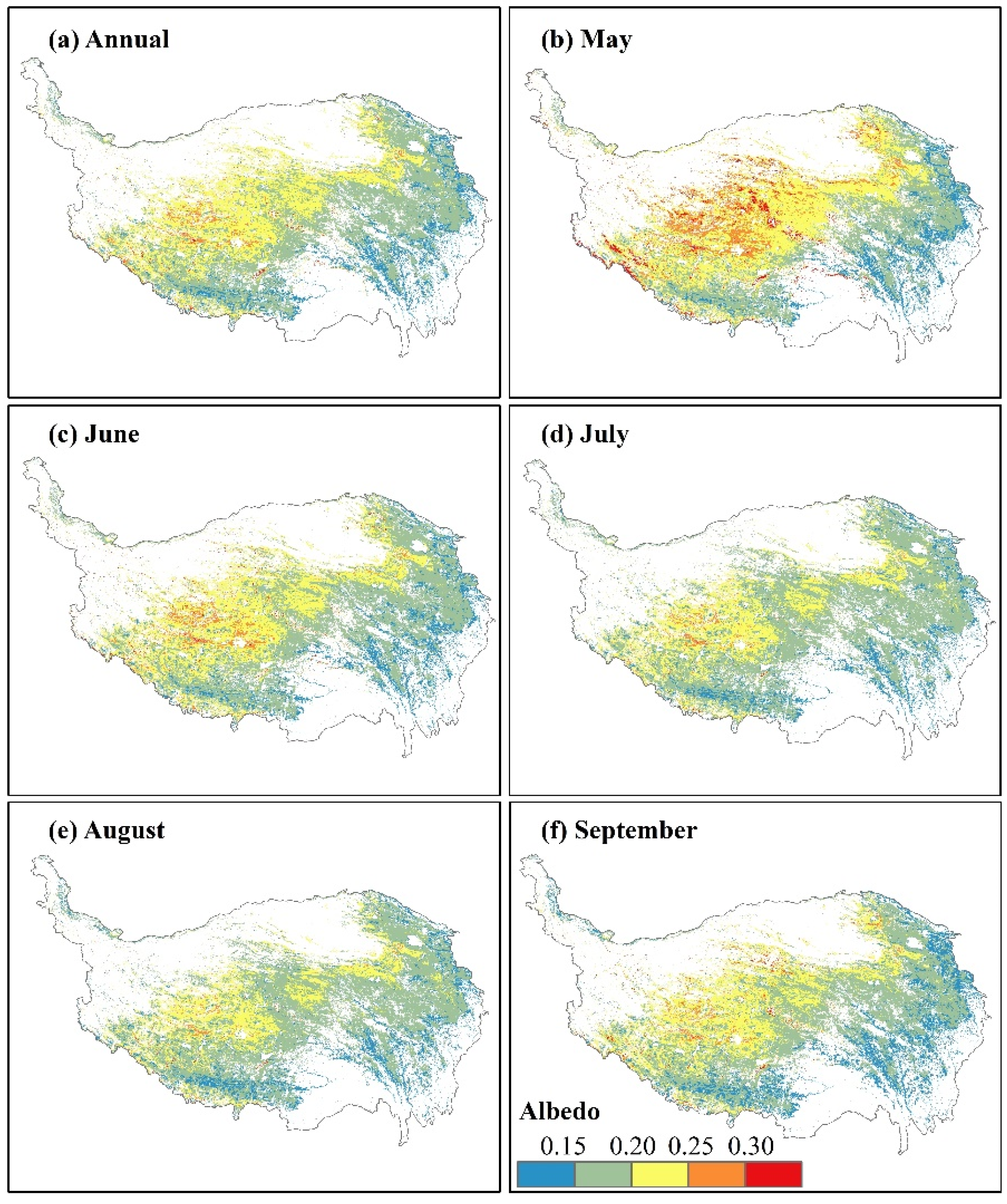
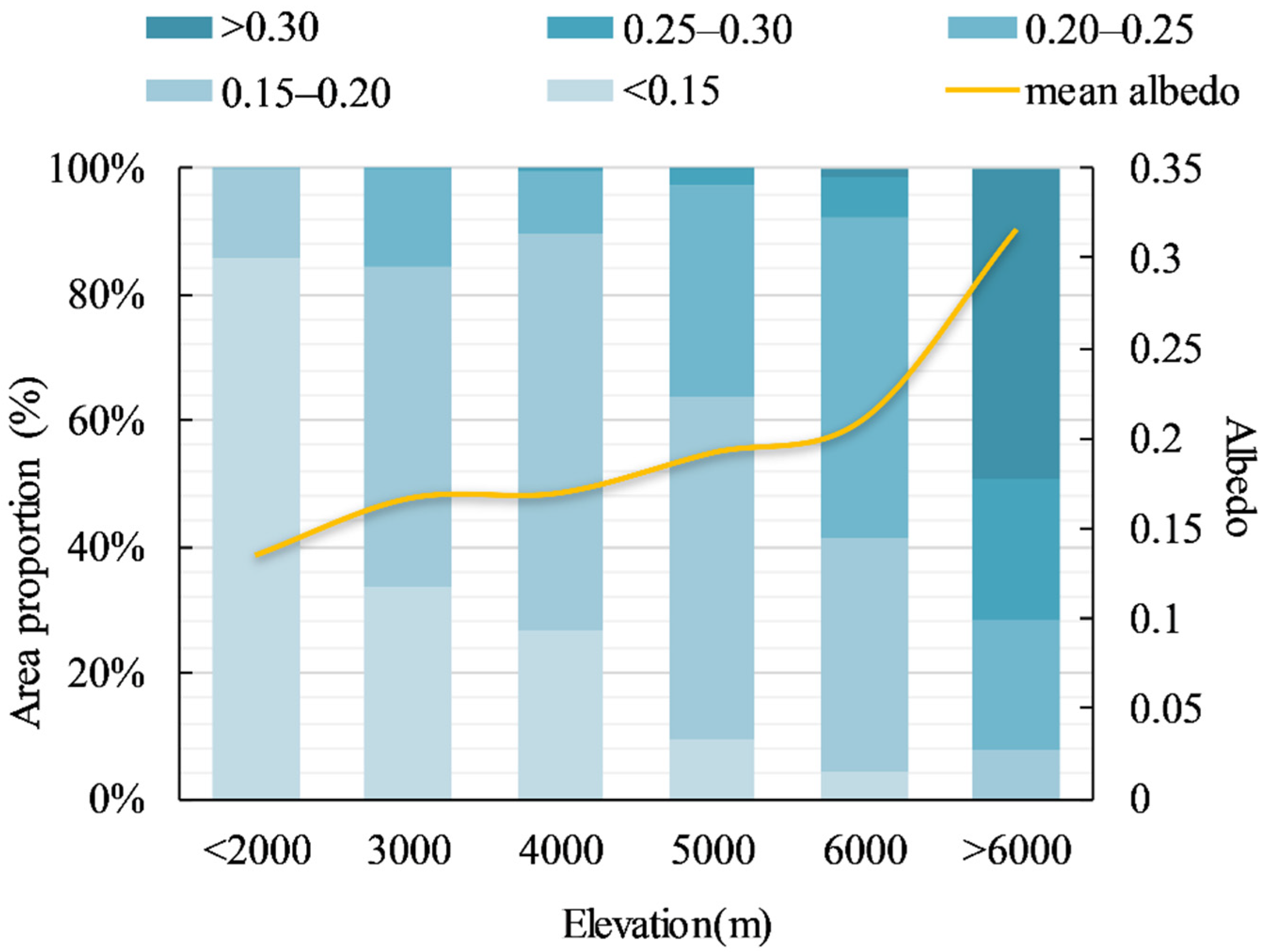
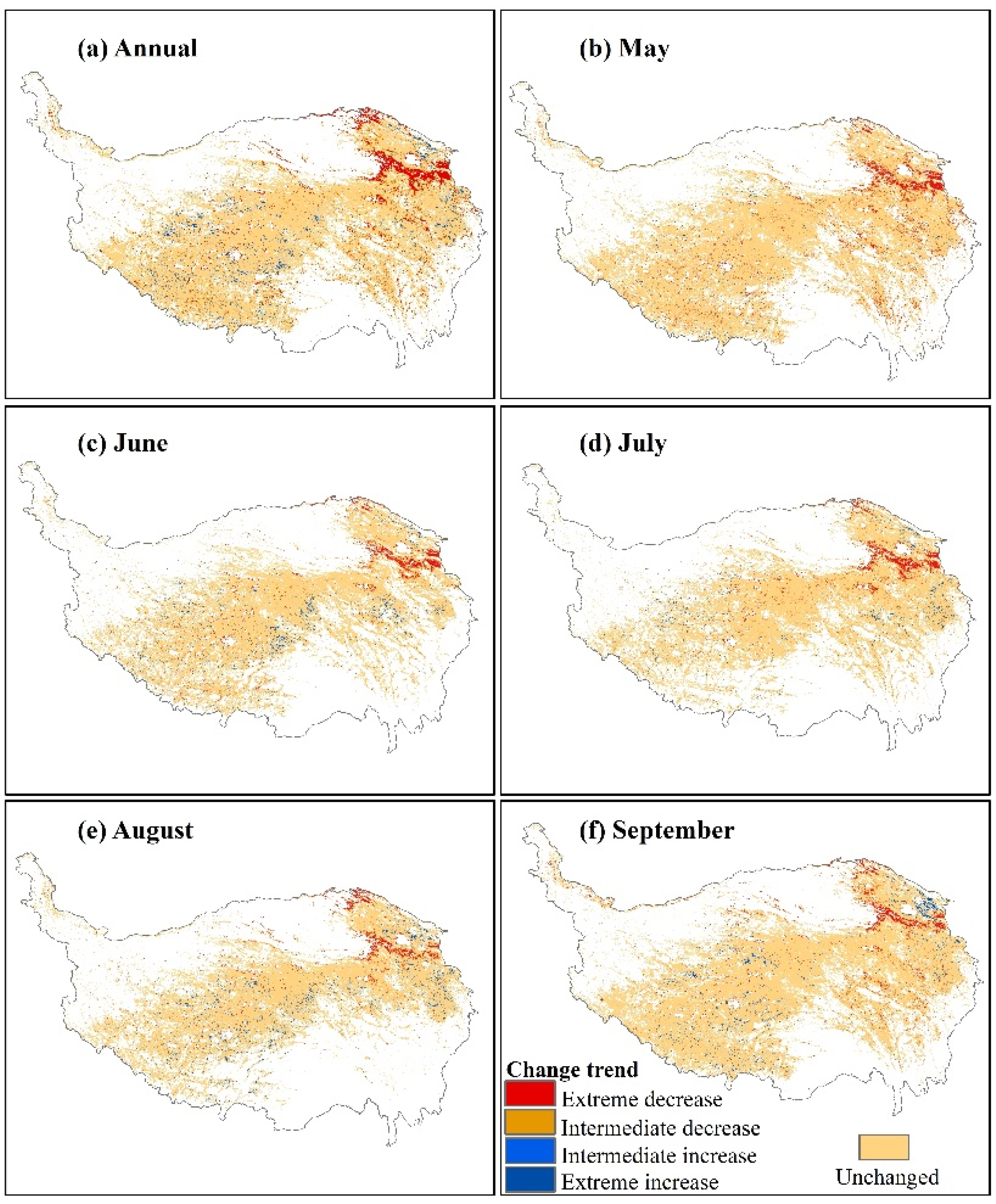
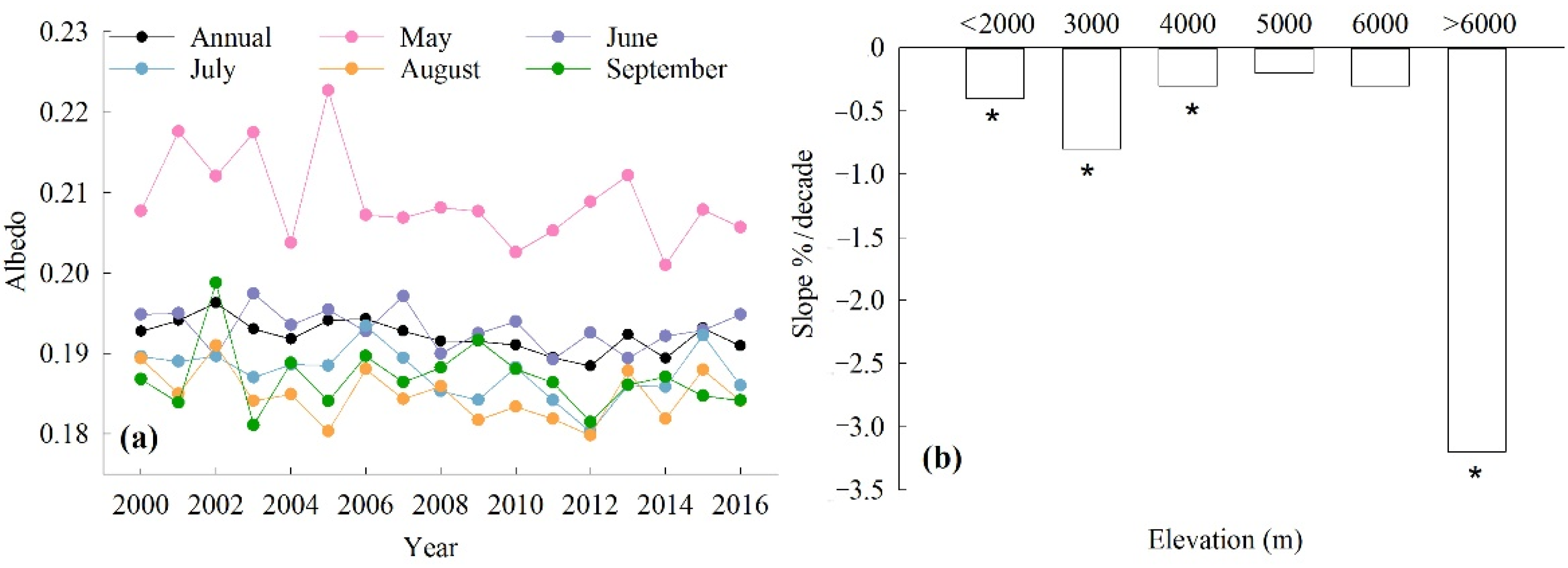

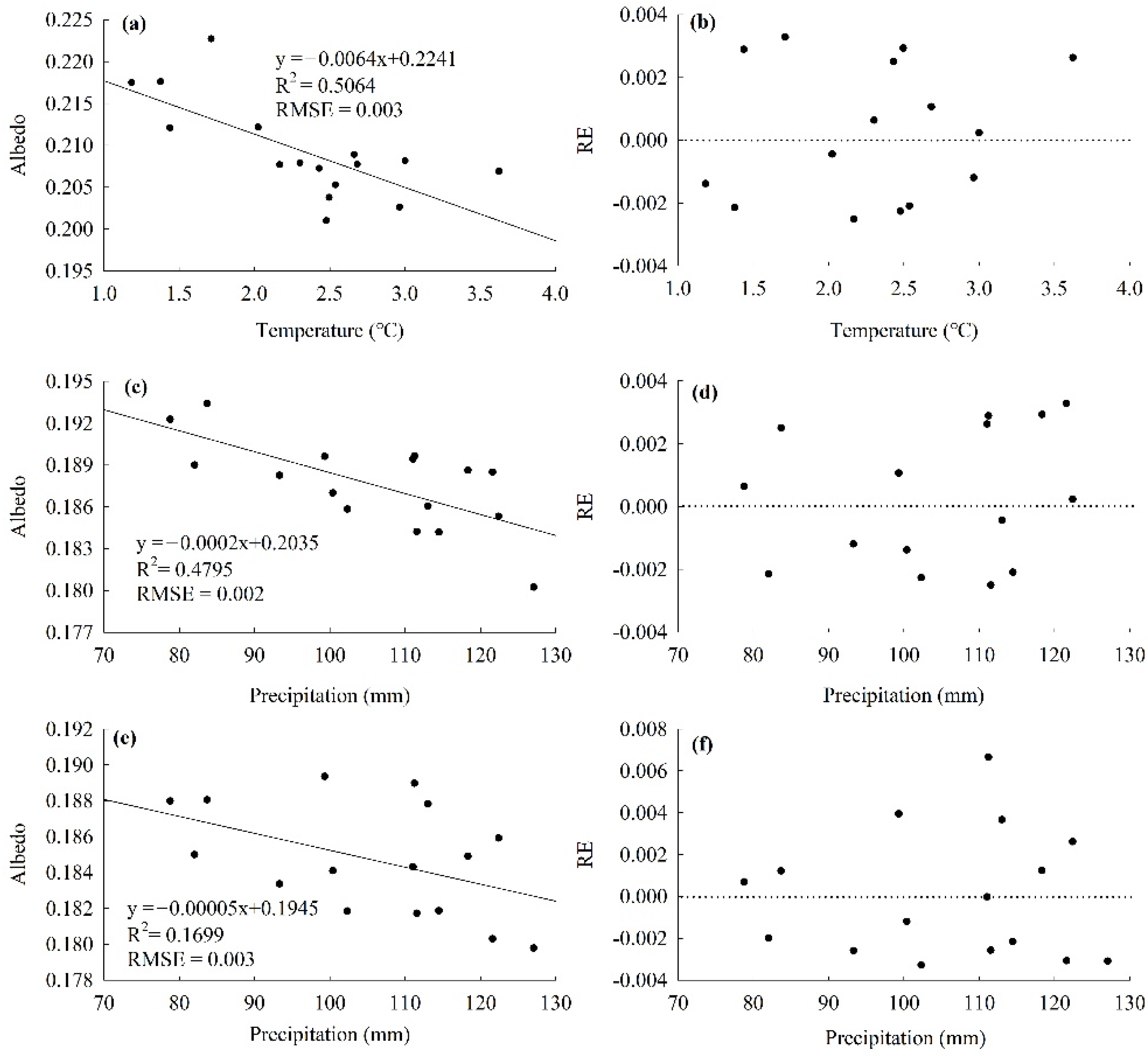
| Sig. Area (103 km2) | Annual | May | June | July | Aug. | Sept. |
|---|---|---|---|---|---|---|
| Decreasing (%) | 181.52 (13.10%) | 145.28 (10.94%) | 74.44 (6.89%) | 87.44 (7.97%) | 69.82 (11.43%) | 98.62 (13.21%) |
| Extreme (%) | 94.93 (6.85%) | 58.54 (4.41%) | 34.75 (3.22%) | 39.28 (3.58%) | 33.80 (5.53%) | 42.92 (5.75%) |
| Intermediate (%) | 86.59 (6.25%) | 86.74 (6.53%) | 39.69 (3.67%) | 48.16 (4.39%) | 36.02 (5.90%) | 55.70 (7.46%) |
| Increasing (%) | 48.82 (3.52%) | 14.77 (1.11%) | 36.60 (3.39%) | 25.99 (2.37%) | 44.62 (7.30%) | 40.38 (5.41%) |
| Extreme (%) | 14.97 (1.08%) | 3.42 (0.26%) | 8.73 (0.81%) | 5.98 (0.55%) | 11.01 (1.80%) | 11.10 (1.49%) |
| Intermediate (%) | 33.85 (2.44%) | 11.35 (0.85%) | 27.87 (2.58%) | 20.01 (1.82%) | 33.61 (5.50%) | 29.28 (3.92%) |
| Annual | May | June | July | Aug. | Sept. | |
|---|---|---|---|---|---|---|
| Slope(%/decade) | −0.25 | −0.53 | −0.16 | −0.23 | −0.21 | −0.20 |
| p | 0.01 | 0.05 | 0.22 | 0.14 | 0.39 | 0.05 |
| R2 | 0.39 | 0.22 | 0.10 | 0.12 | 0.11 | 0.06 |
| Sig. Area (103 km2) (%) | Negative Correlation | Extreme Negative Correlation | Intermediate Negative Correlation | Positive Correlation | Extreme Positive Correlation | Intermediate Positive Correlation |
|---|---|---|---|---|---|---|
| Albedo- | 33.24 | 9.22 | 24.02 | 99.99 | 30.27 | 69.72 |
| Temperature | (2.40%) | (0.66%) | (1.73%) | (7.21%) | (2.18%) | (5.03%) |
| Albedo- | 158.37 | 60.36 | 98.01 | 19.69 | 4.49 | 15.2 |
| Precipitation | (11.62%) | (4.35%) | (7.27%) | (1.42%) | (0.32%) | (1.10%) |
| Month | CM | PM | MBL | TPM | ||||
|---|---|---|---|---|---|---|---|---|
| Temp. | Precip. | Temp. | Precip. | Temp. | Precip. | Temp. | Precip. | |
| May | −0.710 ** | 0.089 | −0.094 | 0.077 | −0.157 | 0.217 | 0.103 | 0.353 |
| June | −0.423 | 0.038 | −0.030 | −0.350 | 0.078 | −0.005 | 0.102 | −0.073 |
| July | 0.113 | −0.690 ** | −0.174 | 0.303 | −0.089 | 0.173 | −0.150 | 0.363 |
| Aug. | −0.163 | −0.295 | 0.044 | −0.413 * | 0.156 | 0.413 | −0.128 | 0.293 |
| Sept. | −0.190 | −0.106 | −0.212 | −0.205 | 0.288 | 0.055 | 0.240 | −0.097 |
Publisher’s Note: MDPI stays neutral with regard to jurisdictional claims in published maps and institutional affiliations. |
© 2021 by the authors. Licensee MDPI, Basel, Switzerland. This article is an open access article distributed under the terms and conditions of the Creative Commons Attribution (CC BY) license (https://creativecommons.org/licenses/by/4.0/).
Share and Cite
Chen, C.; Tian, L.; Zhu, L.; Zhou, Y. The Impact of Climate Change on the Surface Albedo over the Qinghai-Tibet Plateau. Remote Sens. 2021, 13, 2336. https://doi.org/10.3390/rs13122336
Chen C, Tian L, Zhu L, Zhou Y. The Impact of Climate Change on the Surface Albedo over the Qinghai-Tibet Plateau. Remote Sensing. 2021; 13(12):2336. https://doi.org/10.3390/rs13122336
Chicago/Turabian StyleChen, Chaonan, Li Tian, Lianqi Zhu, and Yuanke Zhou. 2021. "The Impact of Climate Change on the Surface Albedo over the Qinghai-Tibet Plateau" Remote Sensing 13, no. 12: 2336. https://doi.org/10.3390/rs13122336
APA StyleChen, C., Tian, L., Zhu, L., & Zhou, Y. (2021). The Impact of Climate Change on the Surface Albedo over the Qinghai-Tibet Plateau. Remote Sensing, 13(12), 2336. https://doi.org/10.3390/rs13122336





